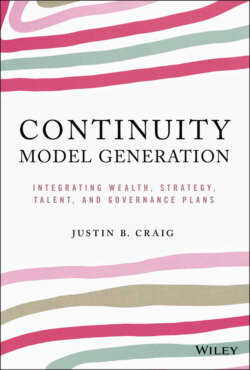Читать книгу Continuity Model Generation - Justin B. Craig - Страница 15
Resource-Based View
ОглавлениеThe resource-based view (RBV) of the firm suggests that firms survive based on their ability to combine heterogeneous and imperfectly mobile resources. Broadly, the RBV incorporates the complex, idiosyncratic, and unique nature of a firm's internal processes and intangible assets, including the values, beliefs, symbols, and interpersonal relationships that individuals or groups within the firm possess. As such, the RBV focuses on an analysis of the nature, characteristics, and potential of a firm's resource base and assumes that each firm's internal resources and capabilities are heterogeneous, which ultimately delivers a competitive advantage. Barney (1991) identified that in order to contribute optimally to firm sustainability, resources must be valuable, rare, imperfectly imitable, and non-substitutable (VRIN).
Resources are defined as anything that could be thought of as a firm's strength or weakness and at any given time could be defined as those (tangible and intangible) assets tied semi-permanently to the firm. Firm resources in the RBV perspective fall into four capital-related categories: physical capital, human capital, organizational capital, and process capital. Overcoming newness means that the venture has been able to distinguish itself from others by building a unique combination of resources in these categories.
Using the RBV framework, Sirmon and Hitt (2003) argued that family businesses evaluate, acquire, shed, bundle, and leverage their resources in ways that are different from those of non-family businesses. In part, these unique resources can emerge from the fact that family members often also act as owners and/or managers. In the family business context, the term “familiness” defines the unique bundle of idiosyncratic resources and capabilities that family firms hold (Habbershon and Williams, 1999). As such, familiness is one of the intangible factors in the RBV (Illustration 4).
Identifying the resource categories that are idiosyncratic is only part of the process. As, if not more important, is understanding what the firm does with resource-related processes or actions. Effectively managing the resources is crucial to creating a competitive advantage and this requires an understanding of how resources are accumulated, bundled, and leveraged. More specifically, Sirmon and colleagues consider resource management to include structuring (i.e. acquiring, accumulating, and divesting) the portfolio of resources, bundling (i.e. stabilizing, enriching, and pioneering) resources to build capabilities, and leveraging (i.e. mobilizing, coordinating, and deploying) capabilities in the marketplace. The synchronization of these processes is important to create value and, in the context of this conversation, contribute optimally to continuity.
Illustration 4 RESOURCE-BASED VIEW
